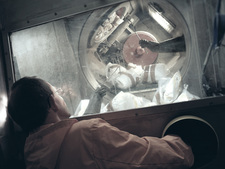-
Topics
subnavigation
Conditioning and containers
- In order to be disposed in a repository radioactive waste has to be treated and processed in an appropriate way.
- Different types of containers are licensed for different types of material.
- The waste producers are responsible for packaging in compliance with the requirements for repositories.

![]() Low-level radioactive waste is burnt in an incineration plant
Low-level radioactive waste is burnt in an incineration plant
Radioactive waste is treated and processed in a special way before it is accepted for disposal in a repository. The term for the treatment and packaging of the radioactive waste is conditioning. To safely package all types of radioactive waste with negligible heat generation and at the same time meet the waste acceptance requirements, various methods or facilities are available for conditioning, depending on the consistency, size and quality of the waste.
Liquid waste is either evaporated or cemented. Solid waste is crushed, dried, burnt, pyrolised, melted, compacted or cemented.
Once the waste has been processed to solid waste products (such as compacted waste or concentrates), it is placed into licensed and standardised containers.
Different containers for different material
Basically there are three types of containers:
- cylindrical concrete containers
- cylindrical cast-iron containers
- containers
Cylindrical concrete containers made from normal or heavy concrete are generally used for immobilised waste. They are filled with drums containing radioactive waste in the order of magnitude of 200 or 400 litres. Existing cavities are subsequently filled with concrete before the lids are attached to the bodies of the drums.
According to requirement, cylindrical cast-iron containers have different measures and wall thicknesses. They are mostly used for the packaging of non-immobilised waste. Here, too, the lid is permanently attached to the body of the container.
Containers are large-volume, rectangular receptacles made from steel plate, reinforced concrete or cast material, which are available in different sizes and wall thicknesses. The largest container with a capacity of just under eleven cubic metres can take up up to 28 twohundred-litre-drums before it is sealed permanently.
Waste producers are responsible for packaging
The responsibility for conditioning is with the waste producers themselves – i.e. the nuclear power plants, research institutions, companies of the nuclear industry or the federal state collecting depots. They are also responsible for choosing the form of packaging. It is essential that these packagings have been approved. According to the waste acceptance requirements, different types of radioactive waste may be packaged together if a reaction between waste, immobilisation material (mostly concrete) and packaging can be ruled out to the greatest possible extent.
| No. | Name | External dimensions | |||
|---|---|---|---|---|---|
| Length/ diameter mm | Width mm | Height mm | Gross volume m3 | ||
| 1 | Type I concrete container | 1060 | - | 1370 1) | 1.2 |
| 2 | Type II concrete container | 1060 | - | 1370 2) | 1.3 |
| 3 | Type I cast-iron container | 900 | - | 1150 | 0.7 |
| 4 | Type II cast-iron container | 1060 | - | 1500 3) | 1.3 |
| 5 | Type III cast-iron container | 1000 | - | 1240 | 1.0 |
| 6 | Type I container | 1600 | 1700 | 1450 4) | 3.9 |
| 7 | Type II container | 1600 | 1700 | 1700 | 4.6 |
| 8 | Type III container | 3000 | 1700 | 1700 | 8.7 |
| 9 | Type IV container | 3000 | 1700 | 1450 4) | 7.4 |
| 10 | Type V container | 3200 | 2000 | 1700 | 10.9 |
| 11 | Type VI container | 1600 | 2000 | 1700 | 5.4 |
| 1) Height 1270mm + strap 90mm = 1460mm 2) Height 1510mm + strap 90mm = 1600mm 3) Height 1370mm in the KfK type 4) Stacking height 1400mm KfK type | |||||
| Container materials are e.g. steel place, reinforced concrete or cast material. | |||||
State of 2017.03.09

